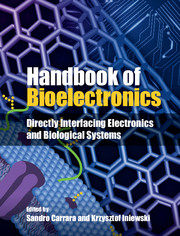Book contents
- Frontmatter
- Contents
- List of Contributors
- 1 What is bioelectronics?
- Part I Electronic components
- Part II Biosensors
- Part III Fuel cells
- 15 Biofuel cells
- 16 Advances and applications in biofuel cells
- 17 Switchable electrodes and biofuel cells logically controlled by chemical and biochemical signals
- Part IV Biomimetic systems
- Part V Bionics
- Part VI Brain interfaces
- Part VII Lab-on-a-chip
- Part VIII Future perspectives
- Index
- References
16 - Advances andapplications in biofuel cells
from Part III - Fuel cells
Published online by Cambridge University Press: 05 September 2015
- Frontmatter
- Contents
- List of Contributors
- 1 What is bioelectronics?
- Part I Electronic components
- Part II Biosensors
- Part III Fuel cells
- 15 Biofuel cells
- 16 Advances and applications in biofuel cells
- 17 Switchable electrodes and biofuel cells logically controlled by chemical and biochemical signals
- Part IV Biomimetic systems
- Part V Bionics
- Part VI Brain interfaces
- Part VII Lab-on-a-chip
- Part VIII Future perspectives
- Index
- References
Summary
Introduction
Every year we see a constant increase in the need for energy. Whereas most ofthis is supplied by large, fixed location units, i.e. power stations anddistribution networks, there is a market for smaller, units which can befixed, portable, or even self-propelling. Much of this need is supplied byproducts such as generators and vehicle engines, but this places a constantdemand on the fossil fuel supply. One potential alternative is the fuelcell.
Conventional fuel cells offer a possible (and partial) solution to thisproblem, allowing the direct production of electricity from the chemicalreaction of a suitable fuel with oxygen obtained from the atmosphere. Themost common type of fuel cell uses hydrogen, but this is of course a gas andhighly explosive, with the storage and transport challenges this entails.Another common series of fuel cells utilize methanol, and other cells havebeen developed that run on other fuels such as hydrocarbons [1,2]. Thesestill, however, utilize highly flammable liquids and are often reliant on afossil fuel supply. Moreover, many of these cells use expensive materialssuch as platinum as catalysts.
There is a wide range of common organic products, often waste products, thatcontain large amounts of stored energy which could potentially be used tosupply energy. Common methods include incineration, but a much moreattractive approach would be to use these materials as fuels in fuelcells.
Information
- Type
- Chapter
- Information
- Handbook of BioelectronicsDirectly Interfacing Electronics and Biological Systems, pp. 202 - 214Publisher: Cambridge University PressPrint publication year: 2015
References
Accessibility standard: Unknown
Why this information is here
This section outlines the accessibility features of this content - including support for screen readers, full keyboard navigation and high-contrast display options. This may not be relevant for you.Accessibility Information
- 1
- Cited by
